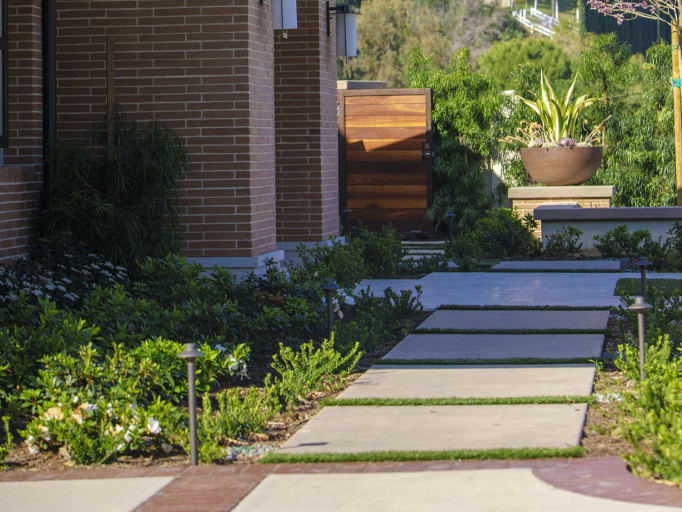
Garden pathsGarden paths are walkways within a garden that guide visitors through the landscape, connecting diff... not only add function and safety to your landscape, but they also provide an aesthetic appeal that can transform the look of your yard. One of the most popular ways to create a garden path is by using pavers on your landscape remodel project, which is versatile and available in various sizes, shapes, and colors.
When done correctly, a paver path can last for decades and withstand foot traffic, rain, and harsh weather conditions. In this article, we'll discuss the step-by-step process of making a garden path with pavers, from preparing the area to laying the pavers and finishing touches.
We'll also share tips and tricks for achieving a professional-looking result, as well as some of our favorite garden path ideas to inspire your next landscape remodel project.
Pavers offer an excellent solution for creating a beautiful and durable garden pathway. The use of pavers in garden design has increased in popularity over the years due to their versatility and aesthetic appeal.
They come in various shapes, sizes, colors, and patterns, allowing you to create a unique design that complements your garden's style. Additionally, pavers offer several benefits such as durability, low maintenance, slip-resistance, and easy replacement if damaged.
There are several types of pavers you can use for your garden pathway, including concrete paversConcrete pavers are precast, man-made paving stones made from a mixture of cement, sand, gravel, and..., natural stone pavers, and brick paversBrick pavers are rectangular, kiln-fired blocks made from clay or shale, used primarily in paving ou.... Each type of paver has its unique characteristics, making it suitable for different garden designs.
For instance, natural stone pavers offer a timeless and elegant look, while concreteConcrete is a composite material made from a mixture of cement, sand, gravel, and water. It is one o... pavers come in various colors and patterns, making them ideal for a modern garden design. Choosing the right type of paver will depend on your garden's style and your personal preferences.
Before installing a paver pathway, it is crucial to prepare your garden adequately. The preparation process involves several steps, including measuring and marking the path's location, clearing the area of any vegetation, and levelingLeveling is the process of creating a flat, even surface in preparation for construction or landscap... the surface.
Start by measuring the path's width and length and marking the path's location using stakes and a string. Clear the area of any vegetation or debris, and ensure the ground is levelA level is a tool used to determine whether a surface is horizontal (level) or vertical (plumb). It .... Next, you will need to excavate the area to a depth of around six inches. You can use a shovelA shovel is a versatile hand tool used in landscaping and construction for digging, lifting, and mov... or rent a plate compactor to ensure the soil is level and firm.
After excavating the area, you will need to add a layer of gravelGravel consists of small, loose, rounded or angular stones, typically ranging in size from a few mil... followed by a layer of sandSand is a fine, granular material composed of finely divided rock and mineral particles. It is a fun... to ensure a level surface. The sand layer should be around two inches thick and compacted using a plate compactor. Once the sand is compacted, you can lay the pavers on top of the sand and level them using a rubber malletA rubber mallet is a type of hammer with a rubber head, used in landscaping and construction to appl....
Building your own paver pathway is a great way to add character and beauty to your garden. Follow these six simple steps to create your own paver pathway:
The design and pattern of your garden paver pathway can enhance the look of your landscape. Pavers come in various shapes, colors, and sizes, making them versatile and perfect for creating unique designs. Popular paver shapes include rectangles, squares, and circles, while popular patterns include herringbone, running bond, and basketweave.
Rectangles and squares are popular shapes for pavers, creating a clean and modern look. Meanwhile, circular pavers can add a unique and artistic touch to your pathway. Herringbone patterns offer a classic and elegant look while running bond creates a simple and modern feel. Basketweave, on the other hand, creates a textured and rustic feel.
The possibilities are endless with pavers, so take the time to explore different designs and patterns to find the perfect fit for your garden pathway.
With proper maintenance, your paver pathway can last for years to come. Regular maintenance helps prevent weed growth, surface erosion, and other damage that can affect the durability of your pathway. Here are some maintenance tips to keep in mind:
Following these maintenance tips can help ensure that your paver pathway stays beautiful and functional for years to come.
If you want to transform your backyard into a beautiful oasis with a garden pathway made of pavers, trust West Hills Masonry to make it happen through our excellent landscape remodel services!
Our team of experienced designers and craftsmen can work with you to create a customized and stunning pathway that meets your needs and preferences. We use only the highest quality materials and techniques to ensure your pathway will be durable and long-lasting.
You can trust that your project will be completed with the utmost care and professionalism. To schedule a consultation and learn more about how we can help you create the garden pathway of your dreams, email us at info@westhillsmasonry.com or contact us at 714-519-5009 at West Hills Masonry today!
 Carlos Gonzales
Carlos GonzalesLocations We Serve
Schedule A Consultation